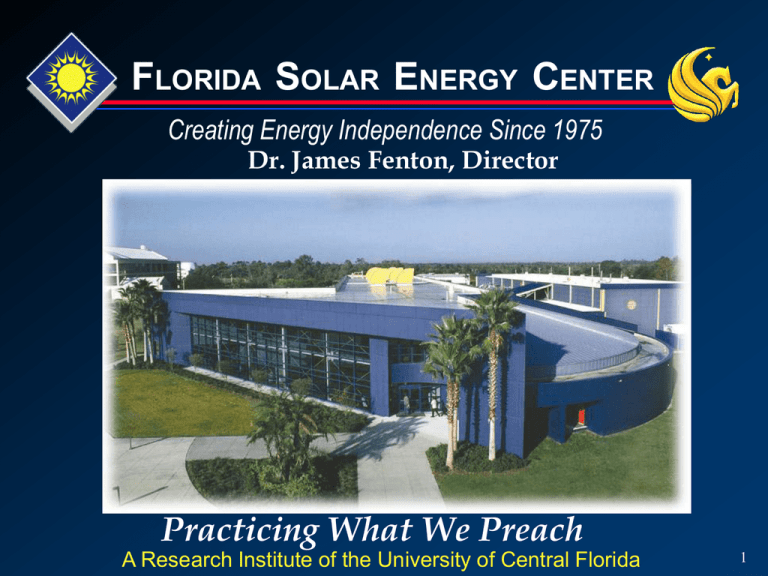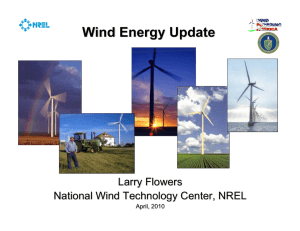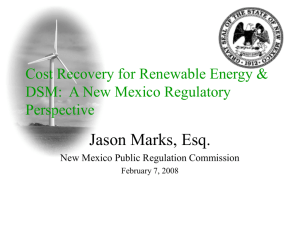F S E C
advertisement

FLORIDA SOLAR ENERGY CENTER Creating Energy Independence Since 1975 Dr. James Fenton, Director Practicing What We Preach A Research Institute of the University of Central Florida 1 Florida Solar Energy Center Program Areas High-Performance Buildings Solar Thermal Systems Photovoltaics Testing & Certification Alternative Fuels, Hydrogen and Fuel Cells (energy efficiency) (today’s cost-effective solution) (tomorrow’s source of electricity) (protecting Florida’s citizens) (the future’s fuels and engines) Education and Training (Florida’s workforce for today and the future) Demonstrations (moving the market) Florida Solar Energy Center $3 million per year in operating funds $8.7 million payroll per year (150 employees) $12 million in contracted research and training per year American Recovery and Reinvestment Act funding $12 million > $20 million Building Research implemented in Florida’s building energy codes and standards saving > $100 million annually in energy costs FSEC support has enabled more than 139,000 solar water heaters installed in Florida saving > $34 million annually in energy costs 3 UCF’s FSEC Leads the Nation U.S. DOE Building America, Energy Efficiency – Only University lead Southeast RES – Photovoltaic applications research Solar Energy Grid Integration – Only University lead Fuel Cell Membranes – FSEC leads 12 univ./industry team Solar Hydrogen Production from water Southern Alternative Energy Training Network – PV Southeast Zero Energy Homes FSEC created the first “Zero Energy Home” in the nation. Gossamer Wind® Ceiling Fan UCF’s most productive patent (> 1.3M sold, > $26M annual energy savings) 4 Renewable Portfolio Standards November 2009 *NV: 25% by 2025 MN: 25% by 2025 (Xcel: 30% by 2020) IA: 105 MW *WA: 15% by 2020 OR: 25% by 2025 (large utilities) 5-10% by 2025 (smaller utilities) MT: 15% by 2015 WI: 10% by 2015 ND: 10% by 2015 CO: 20% by 2020 (IOUs) *UT: 20% *10% by 2020 (co-ops & large munis) KS: 20% MO: 15% by 2025 AZ: 15% by 2025 IL: 25% by 2025 MD: 20% by 2022 DC: 20% by 2020 PA: 18%** by 2020 *VA: 15% by 2025 (co-ops) RES RE Goal Solar water heating eligible TX: 5,880 MW by 2015 HI: 40% by 2030 MA: 15% by 2020 + RI: 16% by 2020 CT: 23% by 2020 NJ: 22.5% by 2021 *DE: 20% by 2019 NM: 20% by 2020 (IOUs) 10% by 2020 NH: 23.8% by 2025 1% annual increase (Class I Renewals) by 2020 by 2021 CA: 33% by 2020 10% by 2017 – new RE VT: 20% by 2017 *MI: 10%+1,100 MW by 2015 SD: 10% by 2015 ME: 30% by 2000 NY: 24% by 2013 OH: 25%** by 2025 NC: 12.5% by 2021 (IOUs) 10% by 2018 (co-ops & munis) Minimum solar or customer-sited RE requirement. *Increased credit for solar or customer-sited RE **Includes separate tier of non-renewable “alternative” energy resources *WV: 25%** by 2025 35 States + D.C. taken from DSIRE: www.dsireusa.org Average Residential Retail Price of Electricity Year to date August 2009 cents per kilowatthour ME: 15.4 MN: 10.1 IA: 10.2 WA: 7.8 OR: 8.7 MT: 8.8 NY: 18.3 WI: 12.1 ND: 7.5 IL: 11.4 SD: 8.4 ID: 7.6 NE: 8.5 NV: 12.7 UT: 8.6 CO: 9.8 AZ: 10.8 NM: 10.2 OK: 8.6 TX: 12.8 CT: 20.2 NJ: 16.6 DE: 14.0 IN: 9.4 KS: 9.7 MO: 8.6 WV: 7.8 KY: 8.4 MD: 15.2 NC: 10.1 TN: 9.4 SC: 10.3 AR: 9.5 MS: 10.1 GA: 10.3 AL: 10.6 PA: 11.7 VA: 10.7 LA: 8.5 AL: 17.2 HI: 23.2 OH: 10.7 NH: 16.5 MA: 17.4 RI: 15.5 MI: 11.7 WY: 8.5 CA: 15.1 VT: 15.0 FL: 12.4 RES RE Goal Coal Mining States Reserves as of December 2005 State (billions) % of U.S. 120 25.4 Illinois (11.4¢) 78 16.5 Wyoming (8.1¢) 68 14.4 West Virginia (7.6¢) 37 8.0 Kentucky (8.3¢) 30 6.3 Pennsylvania (11.1¢) 29 6.1 Ohio (10.0¢) 19 4.0 Colorado (9.4¢) 17 3.6 Texas (13.0¢) 13 2.7 Indiana (9.2¢) 10 2.1 Other States 51 10.9 TOTAL (11.2¢) 472 100.0 (2009 res electricity cost kWhr) Montana (8.6¢) Tons Although 90 percent of the country's coal reserves are concentrated in 10 states, coal in mined in 27 states and can be found in even more. Montana has the most coal, 25 percent of demonstrated reserves. Wyoming, third among states with the most coal, is first in coal output, accounting for 18 percent of annual production.




